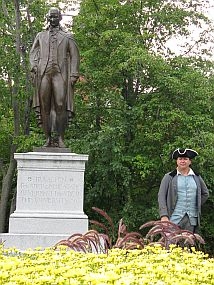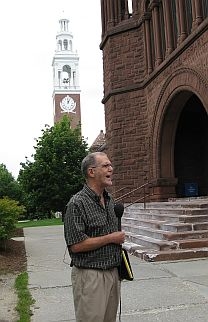 (Host) The University of Vermont traces its history to one man whose family has defined Vermont’s history – Ira Allen.
(Host) The University of Vermont traces its history to one man whose family has defined Vermont’s history – Ira Allen.
In a new historical walking tour of the campus visitors can look into the bronze eyes of Ira Allen and relive the university’s past.
VPR’s Ross Sneyd went along for the first tour.
(Sneyd) Ira Allen himself showed up to explain the somewhat sordid story of his founding of the university on the hill. He offered the state the cash and the land to get UVM started.
(Allen) “It’s true my 4,000 pounds never quite materialized but I did give the state 50 acres of my own land, the center of which you’re sitting on right now, for it’s university. That’s something isn’t it.”
(Sneyd) Actor John Alexander, playing Ira Allen, was speaking at the feet of a statue to Allen at the first stop on the tour.
(Sound of walking across a sidewalk.)
(Sneyd) Every Saturday through October, retired history professor Bill Averyt will lead a 90-minute walk through campus.
(Averyt) “We’re now at university row. If you look from the southern end to the northern end, you’ll see several beautiful buildings that also have great historical significance.”
(Sneyd) There’s Old Mill, completed in 1829, capped with an imposing cupola. Williams Hall, currently surrounded by scaffolding as it’s restored.
And then we come to one of UVM’s architectural gems, the old Billings Library, completed in 1885.
(Averyt) “You see the very strong, kind of rusticated stonework on the exterior walls. If you look toward the nave, just beyond us, the sturdy columns that continue in front of the façade and around the apse here.”
(Sneyd) It’s a Romanesque style adopted from medieval Europe by noted 19th century architect H.H. Richardson. The red stone building with a large arch over the entry is a signature of the UVM campus. The interior of the former library matches the ornamentation of the outside – soaring wood beams, ornate fireplaces.
(Sound of walking across a sidewalk.)
(Sneyd) Most of the buildings on “university row” are named for luminaries from UVM’s past.
The gravesite of one of them is just around the corner, within sight of busy Colchester Avenue. A granite marker notes the site where John Dewey and his second wife are buried. Dewey grew up in Burlington and graduated from UVM. He revolutionized educational thought in the 19th century.
(Averyt) “He stressed that we do not learn by sitting passively and receiving little packages of information from a teacher, but instead we learn by doing.”
(Sneyd) Today, the university green is surrounded by busy Burlington streets. Cars beep and their exhausts belch. Students in t-shirts and shorts walk the paved sidewalks, backpacks over their shoulders. Water spills from a fountain.
(Averyt) “Let’s imagine that we are back in 1791. We’re pretty much standing in a pine forest. Burlington at that time, although chartered in 1763, in fact was merely two small villages.”
(Sneyd) One village was on the Lake Champlain waterfront. The other was just to the north of the existing university green.
 What stands there now pays homage to 1791.
What stands there now pays homage to 1791.
(Averyt) “The Ira Allen Chapel was built in the mid-1920s, the result of a very generous gift to the university by James Wilbur. Wilbur also donated the statue of Ira Allen and played a large role in the resuscitation of Allen’s career, the understanding of his contributions, including some of his human foibles and imperfections – but also more importantly the really amazing accomplishments and achievements that he carried out in his lifetime…
(Sneyd) And those are just some of the highlights. The tour also passes the red stone Royall Tyler Theater – originally built as the men’s gymnasium – Pomeroy Hall – home to UVM’s first medical school – and many other gems. After 217 years of history, there’s plenty to choose from.
For VPR News, I’m Ross Sneyd.